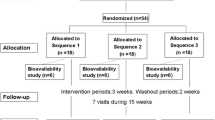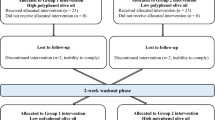Abstract
It is generally believed that virgin olive oil consumption has beneficial effects, but little is known about its effects postprandially on oxidant/antioxidant status. The aim of this study was to determine changes in oxidative stress biomarkers and lipid profile after a single dose of virgin olive oil and after 1 wk of daily consumption. Sixteen subjects (9 men, 7 women) ingested 50 mL of virgin olive oil in a single dose. Blood samples were collected from 0 to 24 h. Thereafter, 14 participants (8 men, 6 women) followed a 1-wk 25 mg/d virgin olive oil dietary intervention. Blood samples were collected at the end of this period. Serum TAG (P=0.016), plasma FA (P<0.001) and lipid peroxidation products in plasma (P<0.001) and VLDL (P=0.007) increased, reaching a peak at 4–6 h, and returning to baseline values at 24 h after oil ingestion. The opposite changes were observed in plasma glutathione peroxidase (P=0.001) and glutathione reductase (GR) (P=0.042). No changes in LDL lipid peroxidation or resistance to oxidation were observed postprandially. At 24 h, plasma oleic acid remained increased (P<0.05) and resistance of LDL to oxidation improved (P<0.05). After 1 wk of virgin olive oil consumption, plasma oleic acid (P=0.031), resistance of LDL to oxidation (P<0.05), and plasma GR activity (P=0.005) increased. These results indicate that changes in oxidant/antioxidant status occur after oral virgin olive oil. Virgin olive oil consumption could provide short-term benefits for LDL resistance to oxidation and in glutathione-related enzyme activities.
Similar content being viewed by others
Abbreviations
- Apo:
-
apolipoprotein
- CHD:
-
coronary heart disease
- GR:
-
glutathione reductase
- GSH-Px:
-
glutathione peroxidase
- MUFA:
-
monounsaturated FA
- OR:
-
oxidation rate
- SFA:
-
saturated FA
References
Pérz, G., Pena, A., Sala, J., Roset, P., Masiá, R., and Marrugat, J. (1998) Acute Myocardial Infarction Case Fatality, Incidence and Mortality Rates in a Population Registry in Gerona, Spain, 1990–1992, Int. J. Epidemiol. 27, 599–604.
De Lorgeril, M., Salen, P., Martin, J.L., Monjaud, I., Delaye, J., and Mamelle, N. (1999) Mediterranean Diet, Traditional Risk Factors, and the Rate of Cardiovascular Complications After Myocardial Infarction. Final Report of the Lyon Diet Heart Study, Circulation 99, 779–785.
Visioli, F. (2000) Antioxidants in Mediterranean Diets, in Mediterranean Diets (Simopoulos, A.P., and Visioli, F., eds.), Vol. 87, pp. 43–45, World Review of Nutrition and Dietatics Series, S. Karger, Basel, Switzerland.
Reaven, P.D., and Witzum, J.L. (1996) Oxidized Low Density Lipoproteins in Atherogenesis: Role of Dietary Modification, Ann. Rev. Nutr. 16, 51–71.
Witzum, J.L. (1994) The Oxidation Hypothesis of Atherosclerosis, Lancet 344, 793–795.
Cohn, S. (1998) Postprandial Lipemia: Emerging Evidence for Atherogenicity of Remnant Lipoproteins, Can. J. Cardiol. 14 (Suppl. B), 18B-27B.
Sattar, N., Petrie, J.R., and Jaap, A.J. (1998) The Atherogenic Lipoprotein Phenotype and Vascular Endothelial Dysfunction, Atherosclerosis 138, 229–235.
Staprans, I., Rapp, J.H., Pan, X.M., Kim, K.Y., and Feingold, K.R. (1994) Oxidized Lipids in the Diet Are a Source of Oxidized Lipid in Chylomicrons of Human Serum, Arterioscler. Thromb. 14, 1900–1905.
Sutherland, W.H., Walker, R.J., de Jong, S.A., van Rij, A.M., Phillips, V., and Walker, H.L. (1999) Reduced Postprandial Serum Paraoxonase Activity After a Meal Rich in Used Cooking Fat, Arterioscler. Thromb. Vasc. Biol. 19, 1340–1347.
Reaven, P., Parthasarathy, S., Grasse, B.J., Miller, E., Almazan, F., Mattson, F.H., Khoo, J.C., Steinberg, D., and Witzum, J.L. (1991) Feasibility of Using an Oleate-Rich Diet to Reduce the Susceptibility of Low-Density Lipoprotein to Oxidative Modification in Humans, Am. J. Clin. Nutr. 54, 701–706.
Berry, E.M., Eisenberg, S., Friedlander, Y., Harats, D., Kaufmann, N.A., Norman, Y., and Stein, Y. (1992) Effects of Diets rich in Monounsaturated Fatty Acids on Plasma Lipoproteins: The Jerusalem Nutrition Study: Monounsaturated Fatty Acids vs. Carbohydrates, Am. J. Clin. Nutr. 56, 394–403.
Mata, P., Varela, O., Alonso, R., Lahoz, C., de Oya, M., and Badimon, L. (1997) Monounsaturated and Polyunsaturated n−6 Fatty Acid-Enriched Diets Modify LDL Oxidation and Decrease Human Coronary Smooth Muscle Cell DNA Synthesis, Arterioscler. Thromb. Vasc. Biol. 17, 2088–2095.
Reaven, P.D., Grasse, B.J., and Tribble, D.L. (1994) Effect of Linoleate-Enriched and Oleate-Enriched Diets in Combination with Alpha-Tocopherol on the Susceptibility of LDL and LDL Subfractions to Oxidative Modifications in Humans, Arterioscler. Thromb. 14, 557–566.
Thomsen, C., Rasmussen, O., Lousen, T., Holst, J.J., Fenselau, S., Schrezenmeir, J., and Hermansen, K. (1999) Differential Effects of Saturated and Monounsaturated Fatty Acids on Postprandial Lipemia and Increatin Responses in Healthy Subjects, Am. J. Clin. Nutr. 69, 1135–1143.
Roche, H.M., Zampelas, A., Jackson, K.G., Williams, C.M., and Gibney, M.J. (1998) The Effect of Test Meal Monounsaturated Fatty Acid: Saturated Fatty Acid Ratio on Postprandial Lipid Metabolism, Brit. J. Nutr. 79, 419–424.
Higashi, K., Ishikawa, T., Tomiyasu, K., Yoshida, H., Ito, T., Nakajima, K., Yonemura, A., Sawada, S., and Nakamura, H. (1997) Olive Oil Increases the Magnitude of Postprandial Chylomicron Remnants Compared to Milk Fat and Safflower Oil, J. Am. Coll. Nutr. 16, 429–434
López, M.C., Satué, T., González, M., and Agramount, A. (1994) Fatty Acid Composition of Trout Oil, Food Chem. 50, 363–365.
Gimeno, E., Calero, E., Castellote, A.I., Lamuela, R., de la Torre, M.C., and López-Sabater, M.C. (2000) Simultaneous Determination of Alpha-Tocopherol and Beta-Carotene in Olive Oil by Reversed-Phase High-Performance Liquid Chromatography, J. Chromatogr. A 881, 251–254.
Singleton, V.L., and Ross, J.A. (1965) Colorimetry of Total Phenolics with Phosphomolybdic-Phosphotungstic Acid Reagent, Am. J. Enol. Vitic. 16, 144–158.
European Union Commission (1999) Commission Regulation (ECC) no 2568/91 of 11 July 1991 on the Characteristics of Olive Oil and Olive-Residue Oil and on the Relevant Methods of Analysis, Official Journal of the European Community L248, 05/09/91, 0001–0082.
Paglia, D.E., and Valentine, W.N. (1967) Studies on the Quantitative and Qualitative Characterization of Erythrocyte Glutathione Peroxidase, J. Lab. Clin. Med. 70, 158–169.
Goldberg, D.M., and Spooner, R.J. (1983) Glutathione Reductase, in Methods of Enzymology (Bergmeyer, H.U., ed.), Vol. 3, pp. 258–265, Verlag Chemie, Basel, Switzerland.
Ródriguez-Palmero, M., López-Sabater, M.C., Castellote-Bargallo, A.I., de la Torre-Boronat, M.C., and Rivero-Urgell, M. (1998) Comparison of Two Methods for the Determination of Fatty Acid Profiles in Plasma and Erythrocytes, J. Chromatogr. A 793, 419–426.
Havel, R.J., Eder, H.A., and Bragdon, J.H. (1955) The Distribution and Chemical Composition of Ultracentrifugally Separated Lipoproteins in Human Serum, J. Clin. Invest. 34, 1345–1349.
Fitó, M., Covas, M.I., Lamuela-Raventós, R.M., Vila, J.S., Torrents, J., de la Torre, C., and Marrugat, J. (2000) Protective Effect of Olive Oil and Its Phenolic Compounds Against Low Density Lipoprotein Oxidation, Lipids 35, 633–638.
Hoving, E.B., Laing, C., Rutgers, H.M., Teggeler, M., van Doormal, J.J., and Muskiet, F.A. (1992) Optimized Deterination of Malondialdehyde in Plasa Lipid Extracts Using 1,3-Diethyl-2-thiobarbituric Acid: Influence of Detection Method and Relations with Lipids and Fatty Acids in Plasma from Healthy Adults, Clin. Chim. Acta 208, 63–76.
Gutteridge, J.M.C. (1995) Lipid Peroxidation and Antioxidants as Biomarkers of Tissue Damage, Clin. Chem. 41, 1819–1828.
Ursini, F., Malorino, M., Brigellus-Flohe, R., Aumann, K.D., Roveri, A., Schomburg, D., and Flohe, L. (1995) The Diversity of Glutathione Peroxidases, Methods Enzymol. 252, 38–53.
Ruíz, C., Alegría, A., Barbera, R., Farre, R., and Lagarda, M.J. (1999) Lipid Peroxidation and Antioxidant Enzyme Activities in Patients with Type 1 Diabetes Mellitus, Scand. J. Clin. Lab. Invest. 59, 99–105.
Efe, H., Deger, O., Kirci, D., Karahan, S.C., Orem, A., and Calapoglu, M. (1999) Decreased Neutrophil Antioxidative Enzyme Activities and Increased Lipid Peroxidation in Hyperlipoproteinemic Human Subjects, Clin. Chim. Acta. 279, 155–165.
Ceriello, A. (2000) Oxidative Stress and Glycemic Regulation, Metabolism 49, 27–29.
Ceriello, A., Bortolotti, N., Motz, E., Pieri, C., Marra, M., Tonutti, L., Lizzio, S., Felett, F., Catone, B., and Taboga, C. (1999) Meal-Induced Oxidative Stress and Low-Density Lipoprotein Oxidation in Diabetes: The Possible Role of Hyperglycemia, Metabolism 48, 1503–1508.
Evans, M., Anderson, R.A., Graham, J.B., Ellis, G.R., Morris, K., Davies, S., Jackson, S.K., Lewis, M.J., Frenneaux, M.P., and Rees, A. (2000) Ciprofibrate Therapy Improves Endothelial Function and Reduces Postprandial Lipemia and Oxidative Stress in Type 2 Diabetes Mellitus, Circulation 101, 1773–1779.
Doi, H., Kugiyama, K., Oka, H., Sugiyama, S., Ogata, N., Koide, S.I., Nakamura, S.I., and Yasue, H. (2000) Remnant Lipoproteins Induce Proatherothrombotic Molecules in Endothelial Cells Through a Redox-Sensitive Mechanism, Circulation 102, 670–676.
Abia, R., Perona, J.S., Pacheco, Y.M., Montero, E., Muriana, F.J., and Ruiz-Gutierrez, V. (1999) Postprandial Triacylglycerols from Dietary Virgin Olive Oil Are Selectively Cleared in Humans, J. Nutr. 129, 2184–2191.
Mabile, L., Salvayre, R., Bonnafe, M.J., and Negre-Salvayre, A. (1995) Oxidizability and Subsequent Cytotoxicity of Chylomicrons to Monocytic V937 and Endothelial Cells Are Dependent on Dietary Fat Composition, Free Radic. Biol. Med. 19, 599–607.
Lechleitner, M., Hoppichler, F., Foger, B., and Patsch, J.R. (1994) Low-Density Lipoproteins of the Postprandial State Induce Cellular Cholesteryl Ester Accumulation in Macrophages, Arterioscler. Thromb. 14, 1799–1807.
Diwadkar, V.A., Anderson, J.W., Bridges, S.R., Gowri, M.S., and Oelgten, P.R. (1999) Postprandial Low-Density Lipoproteins in Type 2 Diabetes Are Oxidized More Extensively Than Fasting Diabetes and Control Samples, Proc. Soc. Exp. Biol. Med. 222, 178–184.
Moore, K., and Roberts, L.J. (1998) Measurement of Lipid Peroxidation, Free Rad. Res., 28, 659–671.
Nicolaïew, N., Lemort, N., Adorni, L., Berra, B., Montorfano, G., Rapelli, S., Cortesi, N., and Jacotot, B. (1998) Comparison Between Extra Virgin Olive Oil and Oleic Acid Rich Sunflower Oil: Effects on Postprandial Lipemia and LDL Susceptibility to Oxidation, Ann. Nutr. Metab. 42, 251–260.
Caruso, D., Berra, B., Giavarini, F., Cortesi, N., Fedeli, E., and Galli, G. (1999) Effect of Virgin Olive Oil Phenolic Compounds on in vitro Oxidation of Human Low Density Lipoproteins, Nutr. Metab. Cardiovasc. Dis. 9, 102–107.
Miró-Casas, E., Farré Alvadalejo, M., Covas, M.I., Ortuño Rodríguez, J., Menoyo Colomer, E., Lamuela Raventós, R.M., and de la Torre, R. (2001) Capillary Gas Chromatography-Mass Spectrometry Quantitative Determination of Hydroxytyrosol and Tyrosol in Human Urine, Anal. Biochem. 294, 63–72.
Bonanome, A., Pagnan, A., Caruso, D., Toia, A., Xamin, A., Fedeli, E., Berra, B., Zamburlini, A., Ursini, F., and Galli, G. (2000) Evidence of Postprandial Absorption of Olive Oil Phenols in Humans, Nutr. Metab. Cardiovasc. Dis. 10, 111–120.
Lee, C., Barnett, J., and Reaven, P.D. (1998) Liposomes Enriched in Oleic Acid Are Less Susceptible to Oxidation and Have Less Proinflammatory Activity When Exposed to Oxidizing Conditions, J. Lipid Res. 39, 1239–1247.
De la Cruz, J.P., Quintero, L., Villalobos, M.A., and Sanchez de la Cuesta, F. (2000) Lipid Peroxidation and Glutathione System in Hyperlipemic Rabbits Influence of Olive Oil Administration, Biochim. Biophys. Acta 1485, 36–44.
Author information
Authors and Affiliations
Corresponding author
About this article
Cite this article
Fitó, M., Gimeno, E., Covas, MI. et al. Postprandial and short-term effects of dietary virgin olive oil on oxidant/antioxidant status. Lipids 37, 245–251 (2002). https://doi.org/10.1007/s11745-002-0887-1
Received:
Revised:
Accepted:
Issue Date:
DOI: https://doi.org/10.1007/s11745-002-0887-1




